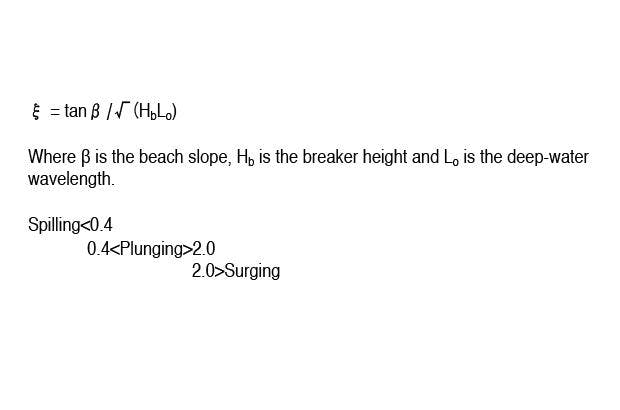UncategorizedWhy and How Waves Break

The old saying that “Eskimos have a hundred different words for snow” is a myth that was discredited and debunked years ago, and yet it still rears its misleading head every so often. Surfers don’t have anywhere near that many words to describe the different types of wave, but we can and do categorise breaking waves, both casually and scientifically. Waves break when they become too steep and the velocity of the water particles at the crest of the wave exceeds the phase speed (the overall wave speed). This is the scientific way of saying that a wave breaks when the water at the top of the wave is going faster than the water at the bottom of the wave, and the whole moving mass of cyclical wet energy trips over itself. As a set of waves generated by a far-away storm system enter shallow water the waves begin to “feel” the seabed and because of this friction the wave speed decreases, the wave height increases, and the wavelength decreases, so the waves bunch up and become steeper as they approach the shore.
In 1880, Sir George Stokes found the critical steepness of a wave in deep water to be (H/L)max=0.142, however the theoretical point of collapse is when the orbital velocity exceeds the phase speed (H/h)max=1. Since then research into the properties of breaking waves has advanced. Whilst Stokes’ theory stands true for calculating the highest possible wave height at a constant depth, it is of purely academic interest; the depth of the seabed where waves break near the shore is not constant, and wave profiles are not symmetrical.
As a wave nears shore and the depth of water starts to decrease, the frictional effect of the seabed slows the bottom of the wave, and when the point is reached when the top of the wave overtakes the bottom, the wave will break.
It has been found that a wave will break in water that is a depth of 1.3 the wave height. On a beach with a very gradual slope a wave will spill slowly when it reaches a depth of 1.3 x its height, whereas if the transition from deep to shallow water is more abrupt (as it is over a reef) then the wave will break faster and be more hollow. Add in additional influencing factors such as wave speed (groundswell with a longer period moves faster, so breaks with more force) and wave steepness (windswell with a short period is more bunched up, so waves are steeper and break in deeper water) and wind direction, and calculating the break point and the profile of a breaking wave becomes intensely complicated.
The profile of a breaking wave can be used to classify breaker types. In 1968 Cyril J. Galvin conducted experiments in a wave pool recording waves breaking on smooth concrete slopes in order to define breaker types. He divided breaking waves into three types: surging, plunging and spilling. Surging breakers only occur when a long period swell approaches a very steep beach, and the base of the wave surges up the beach before the crest collapses and breaking occurs. Plunging breakers are the ones that surfers draw on their schoolbooks until they’re old and independent enough to dedicate their lives to searching for the real thing; they are the classic wave shape where the crest curls over and plunges down. Plunging breakers on a shore of consistent or gradual gradient (a beach rather than a reef) are produced by long period swells breaking on shallow slopes, or shorter period swells breaking on steep slopes and produce narrow surf zones where the wave’s energy is dissipated over a short distance. The final breaker type encountered is a spilling breaker, where foam or turbulence starts at the crest and spills down the wave face. These occur on shallow slopes (beaches) with short, steep waves and they usually break some distance from shore producing wide surf zones. Breaking waves do not of course sit neatly into these three categories, but rather an observer of the natural environment (where wave heights and periods vary) will witness examples across a wide spectrum. The most commonly used parameter used to predict and classify breaking waves is the Iribarren number (denoted by the Greek letter Xi):

As surfers, we’re all searching for waves in that central bracket, the barreling ones with an Iribarren number between 0.4 and 2.0. But just as wave types sit on a spectrum, so do the waves within each category; barreling (plunging) waves can range in intensity from waves that break wider than they are tall, right through to the sort of head-dippers that you really have to contort yourself into. The length:width ratio of the cross-section of a barreling wave (note: the longest dimension within the barrel, not the vertical height) can be used to determine the intensity of the tube, although this is based purely upon the space within the breaking wave and does not take into account the thickness of the lip. Barreling waves can therefore be further sub-divided into the following types:
Square <1:1
1:1< Round> 2:1
2:1> “Almond” shape
Have a think about that over the coming weeks as competition kicks off at Teahupo’o, and you enjoy a live view streamed direct from the channel of the world’s best throwing themselves over the ledge and into enormous barrels. Do most of the waves at Teahupo’o even fit that classification system?